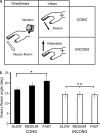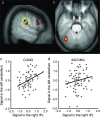Visuokinesthetic perception of hand movement is mediated by cerebro-cerebellar interaction between the left cerebellum and right parietal cortex
- PMID: 18453537
- PMCID: PMC2638744
- DOI: 10.1093/cercor/bhn068
Visuokinesthetic perception of hand movement is mediated by cerebro-cerebellar interaction between the left cerebellum and right parietal cortex
Abstract
Combination of visual and kinesthetic information is essential to perceive bodily movements. We conducted behavioral and functional magnetic resonance imaging experiments to investigate the neuronal correlates of visuokinesthetic combination in perception of hand movement. Participants experienced illusory flexion movement of their hand elicited by tendon vibration while they viewed video-recorded flexion (congruent: CONG) or extension (incongruent: INCONG) motions of their hand. The amount of illusory experience was graded by the visual velocities only when visual information regarding hand motion was concordant with kinesthetic information (CONG). The left posterolateral cerebellum was specifically recruited under the CONG, and this left cerebellar activation was consistent for both left and right hands. The left cerebellar activity reflected the participants' intensity of illusory hand movement under the CONG, and we further showed that coupling of activity between the left cerebellum and the "right" parietal cortex emerges during this visuokinesthetic combination/perception. The "left" cerebellum, working with the anatomically connected high-order bodily region of the "right" parietal cortex, participates in online combination of exteroceptive (vision) and interoceptive (kinesthesia) information to perceive hand movement. The cerebro-cerebellar interaction may underlie updating of one's "body image," when perceiving bodily movement from visual and kinesthetic information.
Figures




References
-
- Allen G, Buxton RB, Wong EC, Courchesne E. Attentional activation of the cerebellum independent of motor involvement. Science. 1997;275:1940–1943. - PubMed
-
- Allin M, Nosarti C, Rifkin L, Wyatt J, Murray R. Visuomotor integration and the cerebellum in adolescents born preterm. Neuroimage. 2005;26:S23. - PubMed
-
- Bard C, Fleury M, Teasdale N, Paillard J, Nougier V. Contribution of proprioception for calibrating and updating the motor space. Can J Physiol Pharmacol. 1995;73:246–254. - PubMed
-
- Beppu H, Suda M, Tanaka R. Analysis of cerebellar motor disorders by visually guided elbow tracking movement. Brain. 1984;107:787–809. - PubMed
Publication types
MeSH terms
LinkOut - more resources
Full Text Sources
Medical

